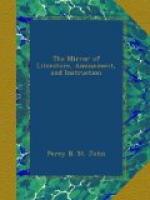The situation of this tomb is one of melancholy picturesqueness. The meadows in which it stands are planted with mulberry-trees. They were, as implied by their name, formerly a resort of the Roman people in hours of gladness: they are no longer devoted to the enjoyment of the living, but to the repose of the dead; “bright and beautiful in the first days of the year was the verdure that covered the meadows of the Roman people."[20] They are now the burial-place of Protestants, and consequently, of foreigners only: by far the greatest part of the strangers interred here are English.
[20] Rome, &c., vol. ii.
[Illustration: (Tomb of Caius Cestius.)]
Time has changed the colour and defaced the polish of the marble pyramid. The grey lichen has crept over it, and wild evergreens hang from its crevices. But, what it has lost in splendour it has gained in picturesque beauty; and there are few remains of antiquity within the bounds of the Eternal City, that the eye rests upon with such unwearying admiration as this grey pyramid.
Lastly is the reputed Tomb of the Horatii and Curatii.
Its identity has been much controverted, and the Cut shows it to be a ruinous pile capped with luxuriant foliage. It will, nevertheless, serve to illustrate the stupendous character of the ancient Roman tombs.
[Illustration: (Tomb of the Horatii and Curatii.)]
The theatre of the celebrated combat between the Horatii and Curatii lies about five miles from the city of Rome. Several tombs stand on the side of the hillock that borders these fields, but no one in particular is there pointed out as belonging to the unhappy champions. The monuments, however, existed in Livy’s time, and Eustace supposes that “as their forms and materials were probably very plain and very solid, they must have remained for many ages after, and may be some of the many mounds that still stand in clusters about the very place where they fell.” This explanation will not, however, refer to the above engraving, as the buildings in the distance will show.
* * * * *
NEW BOOKS.
* * * * *
BOYHOOD AND EDUCATION OF JAMES THE FIRST.
(From Lives of Scottish Worthies, vol. 2.)
[James I. king of Scotland was born in 1394. In 1405, he was sent by his father, Robert III., to France to escape the danger to which he was exposed by the ambition of his uncle, but being taken by an English squadron, he and his whole suite were carried prisoners to the Tower of London. Here he received an excellent education from Henry IV. of England, who placed him under the care of Sir John de Pelham, constable of Pevensey Castle, to which the youthful and royal captive was conducted. Pelham was a man of note, both as a statesman and a warrior, and on all occasions, Henry appears to have manifested for him a high esteem and consideration. The youthful portrait of James is thus drawn by Mr. Tytler in the above-named work.]




